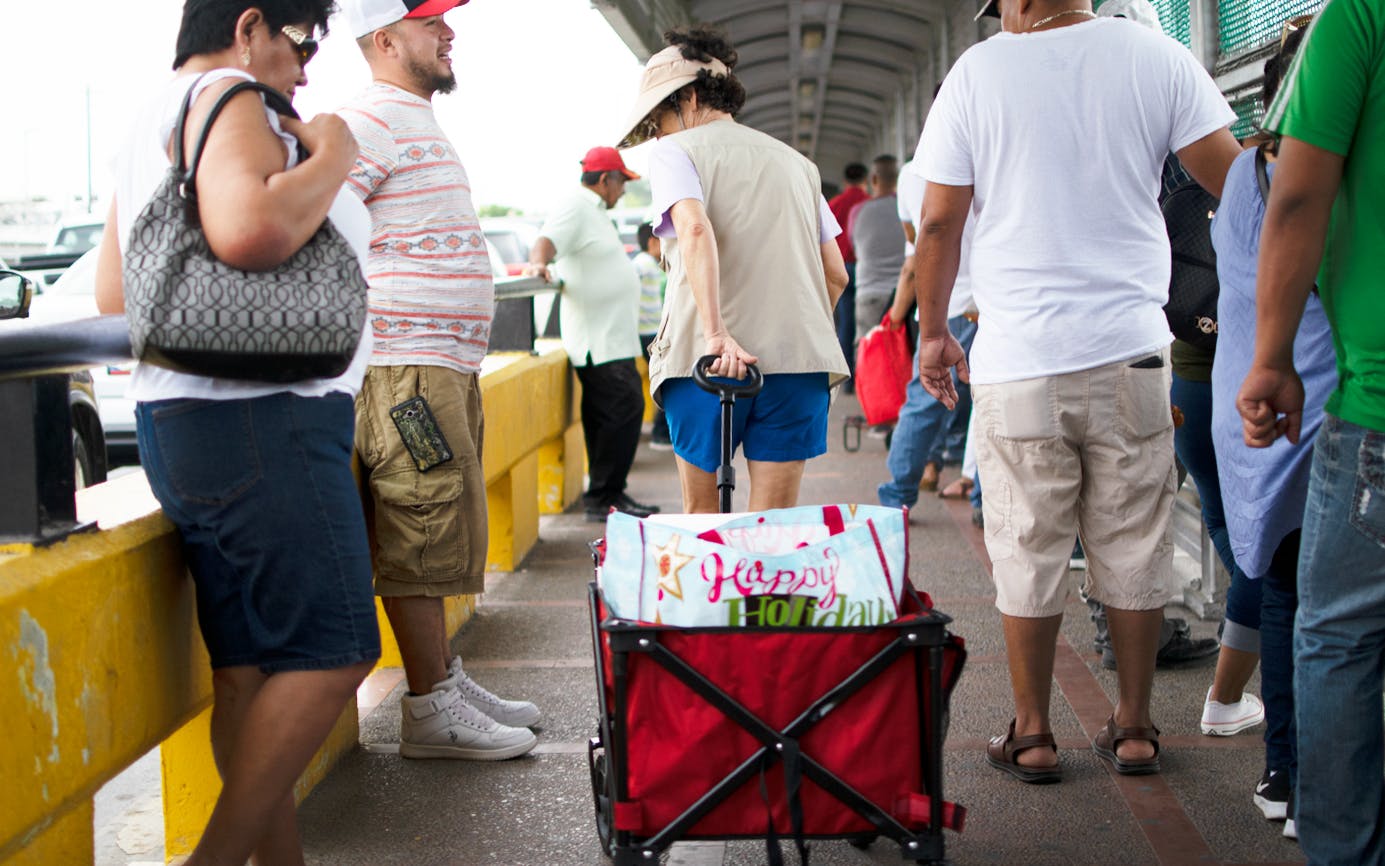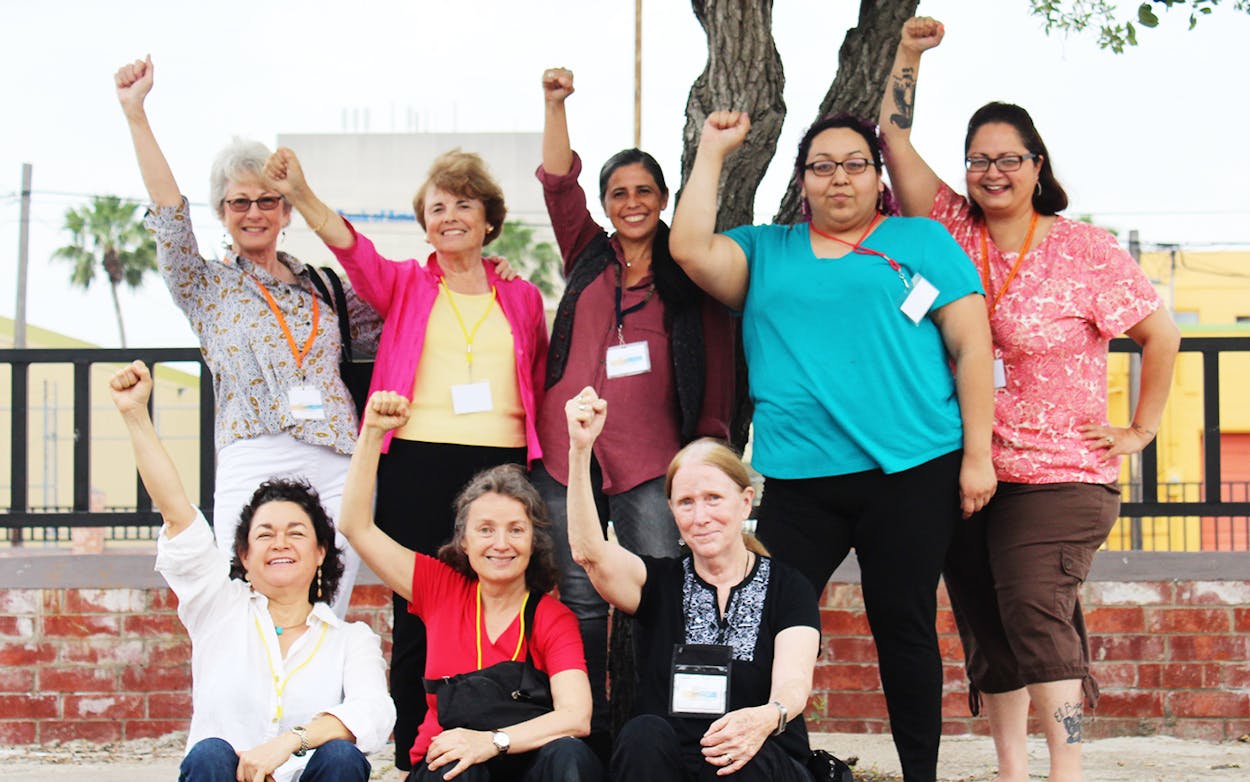It’s an early summer morning in Brownsville as Elisa Filippone loads supplies from her car into Therese Gallegos’s red wagon. She tucks clothes next to rolls of toilet paper and tosses in a few snacks and toys. Before they set off, the two women check to make sure they haven’t forgotten the baby formula and diapers. The week before, Gallegos had made a note of what the parents on the Gateway international bridge needed. She didn’t want to forget anything on their wish list.
It only takes a few minutes for Gallegos to cross into the Mexican side of the Gateway bridge. In Spanish, Gallegos—a small woman with short, curly brown hair that peeks out from a khaki-colored sun visor—calls out to the crowd of asylum seekers gathered on the bridge.
“Tengo ropa, tengo leche para la gente con bebes!” she cries. “I have clothes, I have milk for the people with babies!”
The group of migrants—about thirty in total—are keeping to themselves, chatting quietly on curbs and park benches in the small plaza on the bridge. It takes a minute, but then a young woman named Pilar approaches the cart to grab a pair of leggings, and others begin making their way toward Gallegos. Now, she’s completely surrounded by people, doling out supplies as her wagon quickly empties. The children rush to share their new toys with one another.
Gallegos and Filippone are members of the Angry Tías y Abuelas, a grassroots effort founded last summer by a group of women in the Rio Grande Valley after they learned that a few dozen families had been camped out on the international bridge connecting Hidalgo, Texas, and Reynosa, Mexico. The group’s members come from a variety of backgrounds—some are retired, others are still working, and several had previous experience with activism and community organizing. When they first got together in June 2018, it was Jennifer Harbury, a 68-year-old human rights lawyer and one of the group’s founding members, who suggested the name, saying: “You seem like a lot of angry tías to me.” When they realized they had a few grandmothers in their ranks too, they settled on their name: the Angry Tías y Abuelas.
The Tías provide direct relief to migrants at the bridges and bus stations in the area, coordinate with their counterparts in Mexico, and also serve as the eyes and ears of the Rio Grande Valley. They also use Facebook to report to the community what they’re hearing from migrants. If you want to understand what’s happening on the frontlines of the migrant crisis at the border, the Angry Tías y Abuelas are not a bad place to start.
Before leaving the Gateway bridge, Gallegos strikes up a conversation with a few Cubans. Like the rest of the migrants camping out on the bridge, the Cubans are in limbo. They’re idling as they wait for U.S. immigration authorities to allow them to cross into the U.S. to make an asylum claim. Just a few days ago, they were strangers from different parts of their home country. Here on the bridge, they’ve formed bonds.

Gallegos quickly gathers that the Cubans have been stuck in Mexico—either on the bridge or in Matamoros motels and shelters—anywhere from a few days to over a month. They came to the border thinking the process to seek asylum would be fairly straightforward. But they didn’t realize that the Trump administration has recently taken extraordinary measures to make things increasingly difficult for asylum seekers, from imposing a metering policy that allows only small groups of migrants to present themselves at ports of entry, to forcing many to stay in Mexico while their cases are heard under the “Remain in Mexico” directive, to a new policy that requires would-be asylees to apply for refuge in another country before they’re eligible to even seek legal status in the U.S. It was hard for them to find any information about the asylum process before they made the journey to Mexico. Still, the Cubans held out hope they would find political refuge in the United States.
“At least you all have freedom,” says Eunice, a 26-year-old Cuban woman. “We don’t. What we’re doing here, right now, it’s illegal in Cuba. We can’t get together on the streets and talk about the government. We can’t even do what you’re doing, bringing a cart and handing out supplies.”
On our way back into Brownsville, Gallegos pauses to chat with the agent checking her passport at the Customs and Border Protection office. “Have you heard of the Angry Tías? The Angry Tías y Abuelas. We bring supplies to people on the other side of the bridge—books, clothes, food. We’re always looking for donations,” she says. He nodded politely and then we went on our way. Gallegos never misses a chance to drum up support. The week before, her hard-sell to a stranger at the library yielded a small collection of books for the kids on the bridge, she said.
The Tías are conscientious about what donations they bring. Baby formula needs to be shelf-stable because many of the asylum seekers have been waiting on the bridge for over a week, and breakfast bars with peanuts are best because of the extra protein. After watching families sweat following hours in the sun, Filippone secured a water cooler for people to share.
The Tías’ outreach efforts began at the Reynosa-Hidalgo Bridge but quickly expanded. When Border Patrol began routinely dropping off busloads of families at bus stations throughout the Valley later in summer 2018, the Tías refocused some of their efforts there. Dazed from long journeys, disoriented from the chaos of the U.S. immigration system, and often unsure about their next steps, migrants often rely on the kindness of the Tías to help them in small ways. Volunteers provide them with backpacks stuffed with basic necessities as well as information packets outlining travel information and access to free legal services. When Filippone first joined the Tías, she traveled to the Brownsville Greyhound station every night, making sure that any migrants she saw who arrived late were safe. On more than one occasion, she helped people who had been dropped off late at night find a place to stay.
By the end of their first summer together, their initial act of kindness had blossomed into an organized act of resistance. Within the first six months of their launch, the group raised roughly $70,000 to provide basic necessities to migrants waiting on the other side of the bridge. They’ve attended a number of protests throughout the Valley, raising their voices against the wall or against family separations.
“We try to be wherever we can be,” says Joyce Hamilton, one of the co-founders. “We’re active women, and we work almost daily [to help immigrants].”
The workload has increased and gotten more difficult for the Tías over the past year. Because of the “Remain in Mexico” rule and the requirement that people first apply for asylum in a third country, the Tías are seeing hundreds of people sent back into Mexico each week. Some grow restless and try to cross the river, putting their lives in jeopardy.


“Their situation is desperate, but we’re constantly having to reassess because we’re also trying to help immigrants who are already here on U.S. soil fighting for their cases,” Filippone says.
In June, the Tías received a $10,000 Robert F. Kennedy Human Rights Award for their work. Though the award money won’t cover all of the fees associated with an asylum case, it was the start of a newly created legal aid fund that will alleviate legal fees for a few migrants this year.
It’s been over a year since this group of women began their journey together, and Filippone sees no end in sight. She’s gotten used to hearing people talk about “all those people at the bridge,” or explaining to neighbors that it’s local groups, and not the federal government, that are paying to feed and clothe migrants on the bridge. The disparaging talk has cost her more than a few friendships.
“Whoever is against immigration is against everybody,” Filippone says. “People look at these immigrants as if they’re less than them. Either way, what I see is that my government isn’t doing what it should be doing. It’s scary. We should be treating these people with respect.”
Each day since last summer, the Tías slip between two worlds they’ve come to know very well: In one world, the system is constantly changing, separating families or leaving them to wait in Mexico, where they may face the same violence they’re running from. In the other, volunteers and community members donate their money and time, rallying together to protest, raise awareness, and bring comfort to the people waiting at the bridge.
The Tías often sign off their Facebook updates with one reminder: This is America.
- More About:
- Politics & Policy
- Brownsville








